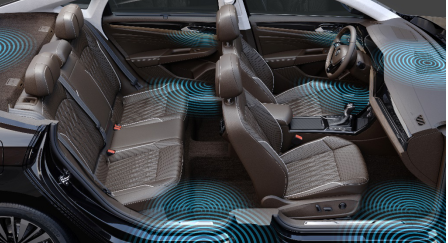NVH test equipment
Four column vibration exciter
Vibration exciter
accelerometer
microphone
Power dynamometer
Test software
Multi-channel NVH data acquisition system
Acoustic holography equipment
Laser vibrometer
Semi/full anechoic test room

NVH analysis
There are several methods for analyzing NVH (noise, vibration and sound roughness). Here are some common NVH analysis methods:
Spectrum analysis: The signal is converted into frequency domain data, and the frequency component and energy distribution of noise and vibration are identified by spectrogram and spectral component analysis.
Waveform analysis: Time and amplitude observation and analysis of time domain signals to understand the timing characteristics of noise and vibration, such as fluctuations, periodic and transient responses.
Frequency response analysis: By comparing the frequency spectrum of the system excitation signal with the response signal, the frequency response function of the system is obtained to evaluate its frequency response range, resonance and transfer function.
Modal analysis: By measuring the vibration response signal, the natural vibration mode of the structure and the corresponding frequency, damping and mode and other information are determined.
Phase analysis: The phase relationship of the signal is analyzed to understand the temporal phase difference between vibration and noise, and to identify resonance points and coherence.
Statistical energy analysis: Calculate and compare the energy contributions of different frequency bands to determine the main noise and vibration sources by converting the signal into an energy graph.
Identification analysis: Through the model identification technology, extract the mechanical parameters, transfer function and resonance frequency of the system from the vibration or noise signal.
Sound quality assessment: Using subjective hearing and objective parameters, noise is assessed and compared to determine sound quality and comfort.
These analysis methods can be used alone or in combination to select the right method for the specific NVH problem and testing needs. At the same time, with the advancement of technology, many new analytical methods and tools have emerged to improve the accuracy and efficiency of NVH analysis.

NVH control method
1, NVH (noise, vibration and sound) control methods are diverse, the following are some common NVH control methods:
2, structural optimization: Through optimization of structural design, improve stiffness, reduce resonance, reduce vibration and noise levels. For example, in the automotive industry, noise and vibration can be reduced by optimizing body structure, strengthening sound insulation measures, etc.
3, material selection: Select the appropriate materials and acoustic isolation materials to reduce the transmission of noise and vibration. For example, select materials with good sound insulation properties for the manufacture of products.
4, vibration reduction technology: the use of vibration reduction measures to eliminate or reduce the impact of vibration. For example, vibration levels of mechanical equipment are reduced by installing vibration absorbers, vibration pads, etc.
5, active noise control: the use of active noise control technology, real-time monitoring and analysis of noise signals through sensors and control systems, and take appropriate compensation measures to offset or reduce noise. For example, active noise control technology is used in some high-end cars to reduce the impact of external noise on sound quality.
6, noise reduction and sound insulation technology: soundproof materials, soundproof structures or soundproof devices are used to block the path of spreading noise and reduce the interference of external noise. For example, use sound absorbing cotton, sound insulation pad and other sound insulation measures in the door sheet metal.
7, energy saving vibration reduction technology: by changing the working parameters of the system or adjusting the structural parameters, reduce the loss of vibration energy, reduce the vibration and noise level of the system. For example, in the field of engines, balance shaft technology is used to reduce engine vibration and noise.
8, intelligent control technology: the application of intelligent control algorithms and technology, through real-time monitoring and analysis of the status of the system and vibration signals, the system adaptive adjustment and optimization, in order to achieve the best NVH control effect.
You need to select the appropriate control method based on the specific NVH problem and application scenario. At the same time, different methods can also be combined to achieve better NVH control results.

NVH specific case
Some common ways to control noise and vibration inside the car include adding rubber or asphalt materials to the car panels, filling sealants, and injecting expanding foam into the body panels. Rubber or asphalt materials are attached to various automotive panels, increasing damping and mass loading to reduce vibration levels and panel noise. Filler sealants are used to close panel gaps to increase the loss of transmission of engine, wind and tire noise sources to the vehicle interior. Expanding foam injected between panels, such as dashboards and firewalls, helps increase stiffness and vibration absorption.
All of these existing methods effectively reduce vehicle sound and vibration levels at higher frequencies. However, at lower frequencies below 200 Hz, some sound insulation methods are almost ineffective. At the same time, the vehicle NVH performance development should pay attention to the balance of effect and cost, unlimited NVH program will add considerable weight to the vehicle, thus affecting its fuel economy, and increase the cost.




